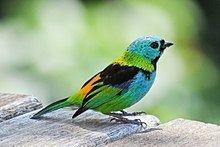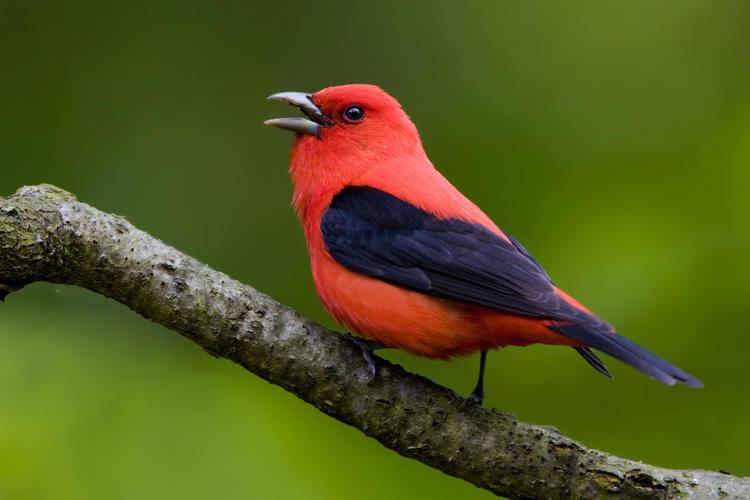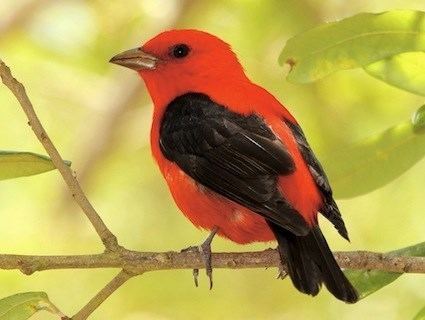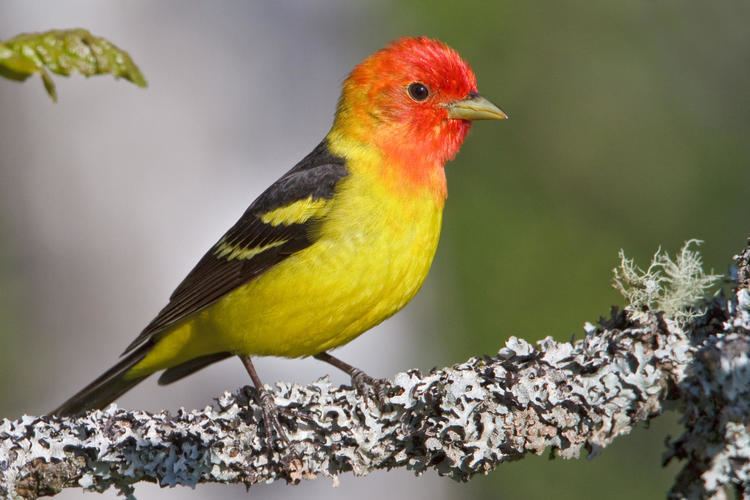Scientific name Thraupidae Phylum Chordata Order Passerine | Superfamily Passeroidea Higher classification Passerine Rank Family | |
 | ||
Lower classifications | ||
Orioles and scarlet tanagers gorge on grape jelly
The tanagers (singular /ˈtænədʒər/) comprise the bird family Thraupidae, in the order Passeriformes. The family has an American distribution. The Thraupidae are the second-largest family of birds and represent about 4% of all avian species and 12% of the Neotropical birds. Traditionally, about 240 species of tanagers were described, but the taxonomic treatment of this family's members is currently in a state of flux. As more of these birds are studied using modern molecular techniques, some genera are expected to be relocated elsewhere. Already, species in the genera Euphonia and Chlorophonia, which were once considered part of the tanager family, are now treated as members of Fringillidae, in their own subfamily (Euphoniinae). Likewise, the genera Piranga (which includes the scarlet tanager, summer tanager, and western tanager), Chlorothraupis, and Habia appear to be members of the cardinal family, and have been reassigned to that family by the American Ornithologists' Union.
Contents
- Orioles and scarlet tanagers gorge on grape jelly
- Description
- Distribution
- Behavior
- Diet
- Reproduction
- Systematics
- Group 1
- Group 2
- Thraupidae incertae sedis
- Group 3 Incertae sedis
- Recently split from Thraupidae
- References

Description

Tanagers are small to medium-sized birds. The shortest-bodied species, the white-eared conebill, is 9 cm (4 in) long and weighs 6 g (0.2 oz), barely smaller than the short-billed honeycreeper. The longest, the magpie tanager is 28 cm (11 in) and weighs 76 g (2.7 oz). The heaviest is the white-capped tanager which weighs 114 g (4.02 oz) and measures about 24 cm (9.4 in). Both sexes are usually the same size and weight. Tanagers are often brightly colored, but some species are black and white. Birds in their first year are often duller or a different color altogether. Males are typically more brightly colored than females. Most tanagers have short, rounded wings. The shape of the bill seems to be linked to the species' foraging habits.
Distribution

Tanagers are restricted to the New World and mainly to the tropics. About 60% of tanagers live in South America, and 30% of these species live in the Andes. Most species are endemic to a relatively small area.
Behavior

Most tanagers live in pairs or in small groups of three to five individuals. These groups may consist simply of parents and their offspring. Birds may also be seen in single-species or mixed flocks. Many tanagers are thought to have dull songs, though some are elaborate.
Diet
Tanagers are omnivorous, and their diets vary from genus to genus. They have been seen eating fruits, seeds, nectar, flower parts, and insects. Many pick insects off branches. Other species look for insects on the undersides of leaves. Yet others wait on branches until they see a flying insect and catch it in the air. Many of these particular species inhabit the same areas, but these specializations alleviate competition.
Reproduction
The breeding season is March through June in temperate areas and in September through October in South America. Some species are territorial, while others build their nests closer together. Little information is available on tanager breeding behavior. Males show off their brightest feathers to potential mates and rival males. Some species' courtship rituals involve bowing and tail lifting.
Most tanagers build cup nests on branches in trees. Some nests are almost globular. Entrances are usually built on the side of the nest. The nests can be shallow or deep. The species of the tree in which they choose to build their nests and the nests' positions vary among genera. Most species nest in an area hidden by very dense vegetation. No information is yet known regarding the nests of some species.
The clutch size is three to five eggs. The female incubates the eggs and builds the nest, but the male may feed the female while she incubates. Both sexes feed the young. Five species have helpers assist in feeding the young. These helpers are thought to be the previous year's nestlings.
Systematics
Phylogenetic studies suggest the true tanagers form three main groups, two of which consist of several smaller, well-supported clades. The list below is an attempt using information gleaned from the latest studies to organize them into coherent related groups, and as such may contain groupings not yet accepted by or are under review by the various ornithological taxonomy authorities.
Group 1
Mainly dull-colored forms
a) Conebill and flowerpiercer group (Also contains Haplospiza, Catamenia, Acanthidops, Diglossa, Diglossopis, Phrygilus and Sicalis traditionally in the Emberizidae) This group despite having a rather varied bill morphology shows marked plumage similarities. Most are largely gray, blue, or black, and numerous species have rufous underparts:
b) True seedeaters. Traditionally placed in Emberizidae, these genera share a particular foot-scute pattern which suggests they may form a monophyletic group:
c) "Yellow-rumped" clade:
d) "Crested" clade (Also contains Coryphospingus and Volatinia traditionally placed in the Emberizidae):
e) "Blue finch" clade, relationships within Thraupidae uncertain, but may be related to Poospiza clade:
f) The Poospiza clade - a diverse but close-knit group containing both warbler- and finch-like forms:
g) Grass and pampa-finches, relationships within Thraupidae are uncertain, but together form a well-supported clade:
h) A miscellaneous and likely polyphyletic group of unplaced "tanager-finches" (which may or may not include the species called tanager-finch) whose members when studied will no doubt be relocated to other clades:
i) Basal forms in Group 1:
Group 2
"Typical" colorful tanagers
a) Tropical canopy tanagers:
b) The "Tholospiza" - Darwin's finches, grassquits, atypical honeycreepers, and some seedeaters: The finch-like forms in this clade were formerly classified in the Emberizidae:
c) Mountain tanagers:
d) Typical tanagers:
e) Typical multicolored tanagers (includes Paroaria, traditionally placed in either Emberizidae or Cardinalidae):
f) Green and golden-collared honeycreepers:
g) Typical honeycreepers and relatives:
h) Basal lineages within group 2:
Thraupidae incertae sedis
Group 3 Incertae sedis
Recently split from Thraupidae
Related to Arremonops and other American sparrows in Emberizidae:
Related to the cardinals in Cardinalidae:
Fringillidae, subfamily Euphoniinae:
